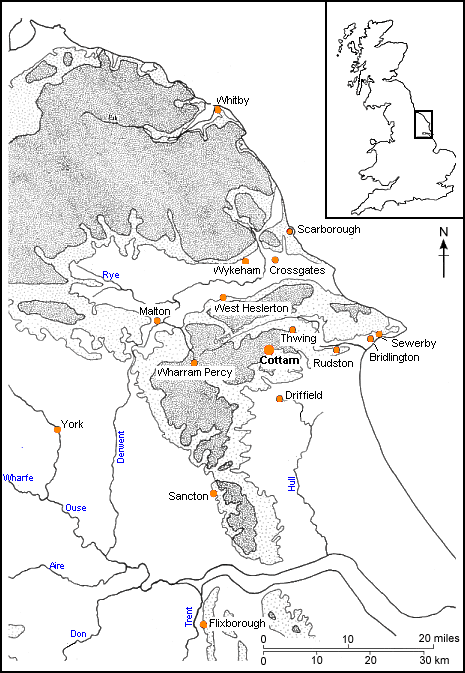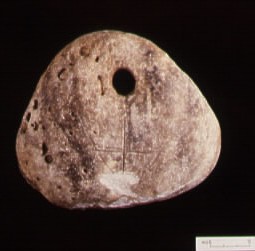Click on Cottam to zoom in to study area

By the early 1990s Anglian Eoforwic and Anglo-Scandinavian Jorvik were comparatively well known from extensive excavations by the York Archaeological Trust, principally at the Fishergate and Coppergate sites (Kemp 1996; Hall 1994). But where were the farms which supplied the people of York with food and where were the farmers who came to market to buy the goods which were traded and manufactured there? Where indeed were the rural settlements from which the rapidly expanding city drew its population? Research into York's hinterland was identified as a major lacuna (Addyman 1984) which the York Environs Project (YEP 1992) sought to fill.
Map 1: Map of north-east England showing the position of Cottam and other
locations
mentioned in the text
Click on Cottam to zoom in to study area

English Heritage had already sponsored a major Anglo-Saxon settlement excavation at West Heslerton (Powlesland et al 1986; Powlesland 1998a; 1998b), where occupation now appears to run on into the eighth century AD. A second landscape project at Wharram Percy had recently drawn to a close and the results published to date (Milne and Richards 1992) offer a tantalising glimpse of eighth-century activity in the Yorkshire Wolds, but raised important questions about chronology, settlement nucleation and continuity. However, by the 1990s most new Anglian and Anglo-Scandinavian sites in the eastern counties were being discovered by 'treasure hunters'. These sites were characterised by large numbers of coins and other metal artefacts and had been dubbed as 'productive' or 'prolific'. Such find spots were rarely examined archaeologically and had come to be regarded as a rather special category of site of unknown function but unusual status (see, for example, Andrews 1992; Bonser 1997; Ulmschneider 2000). 'Productive sites' have now been reported from Hampshire and the Isle of Wight, and throughout Eastern England, especially Yorkshire, Lincolnshire and East Anglia, although their known distribution is generally limited to those areas where archaeologists have been prepared to collaborate with metal detectorists. Several are known from Eastern Yorkshire, including Ryther (Craig Barclay pers comm), South Newbald (Leahy 2000; Booth 1997), several sites 'near Malton' (Booth 1997), as well as Cottam.
One of the best known 'productive sites' is that at Barham, near Ipswich in Suffolk. In all some fifty sceattas and other coins have been recovered as well as other metal objects (Newman 1995, 91-2). Newman argues that such sites must be regarded as economic central places, perhaps even emporia of Hodges 'type A' (Hodges 1982) and in the absence at Barham of archaeological evidence for either settlement or cemetery (Wade 1984) he proposes that they are periodic markets or meeting places (Newman 1999). In a paper on South Newbald, Leahy has demonstrated that there is considerable variation in the numbers and classes of artefacts recovered from so-called 'productive sites', and has suggested that the term conflates several types of site (Leahy 2000). In her doctoral thesis Ulmschneider (1998) has sought to define a Middle Saxon settlement hierarchy for 'productive sites' in Hampshire and Lincolnshire, using find types as indicators of possible function.
The existence of a 'productive site' of the eighth - tenth centuries AD near Cottam, East Yorkshire, was first indicated in 1987 by the discovery by metal detector users of a concentration of Anglian and Anglo-Scandinavian metalwork in a field to the west of Burrow House Farm. When the opportunity arose to carry out archaeological investigation at Cottam it provided an opportunity to build on existing work relating to the Anglian period in North and East Yorkshire, to investigate a 'productive site', and to redress the urban-rural imbalance.
The site would seem to present the sort of opportunity anticipated with some urgency by Watkins in 1983 to fill the gap in knowledge of Middle Saxon settlement sites in the East Riding of Yorkshire. (Haldenby 1990, citing Watkins 1983).
An archaeological evaluation of the Anglian and Anglo-Scandinavian sites at Cottam was conducted from 1993-96, under the auspices of the Department of Archaeology, University of York (Richards 1994). The project was sponsored by the British Academy, with additional sponsorship in the first season from the Earthwatch Foundation. The project was fortunate in gaining the full collaboration of David Haldenby and his colleagues and this report integrates the results of their metal detecting activities of 1987-96, as well as the field walking carried out by the East Riding Archaeological Society in 1989. Further field walking was carried out in January and February 1993 by students of York University Department of Archaeology, demonstrating that ploughing was continuing to bring settlement debris to the surface. The methodology adopted therefore was to combine the results of a number of non-invasive techniques and to undertake small scale excavations which would minimise crop damage, or when there were gaps between harvesting and replanting.
The distribution of datable finds (including pottery) recovered from field walking and metal-detecting suggested that there was indeed a concentration of finds of the eighth and ninth century AD coincident with the crop mark enclosure henceforth referred to as Cottam B. Initially, attention was therefore focussed on this enclosure and in 1993 two trial trenches (COT93.1 COT93.3) were excavated, revealing the presence of timber structures and Anglian settlement debris. The excavation also demonstrated, however, that the site had been heavily truncated by ploughing and that there was little hope of recovering extant occupation levels in this area.
The majority of the tenth century metal artefacts had been recovered from the area to the north of the enclosure. Although there were few coherent crop marks in this area field walking had tended to confirm a possible settlement shift. Sherds of Torksey type ware, introduced in the late ninth or early tenth century, were concentrated to the north of the enclosure. A geophysical survey was subsequently commissioned from Field Archaeology Specialists of York University. Both resistivity and magnetometry were employed and the latter, in particular, revealed a further enclosure system to the north of Cottam B. A second excavation, in 1995 (COT95), revealed that this was a later farmstead whose remains were too shallow to affect the crop growth and to show from the air. Disappointingly this also meant that the settlement remains had again been badly plough damaged and truncated.
Figure 24: Chalk weight from Cottam A

Finally, in 1996, attention turned to the ladder settlement to the south, known as Cottam A. Metal artefacts, including some Anglian and Anglo-Scandinavian finds, had also been found associated with this enclosure, as well as a chalk weight with a possible incised ship graffito (Figure 24; Richards 1995). However, excavation confirmed that this was primarily a Romano-British farmstead with only minimal later activity. The excavations at Cottam A are therefore to be published separately (Richards in prep), although the significance of the results for our understanding of Anglian and Anglo-Scandinavian activity in the area will be discussed below.
The Cottam project therefore embraced a wide range of techniques, including aerial photography, metal-detecting, geophysics, field walking, and excavation. In order to integrate the various categories of evidence and to develop a coherent picture of the spatial development of the site it was decided at an early stage to use a Geographical Information System (GIS), ARC/INFO, in order to aid understanding of both the site and its the broader landscape context. The detailed computing methodology has already been published elsewhere (Richards 1996) and although many of the figures in the present report were created using ARC/INFO, the techniques involved will not be discussed further here.
The project physical archive and finds have been deposited with Hull Museums and Art Galleries; the digital archive has been deposited with the Archaeology Data Service.
© Internet Archaeology
URL: http://intarch.ac.uk/journal/issue10/richards/intro.html
Last updated: Tue May 15 2001